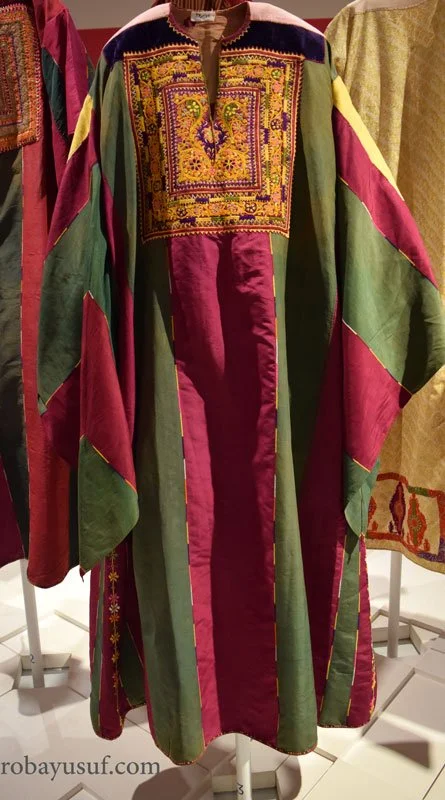Palestinian Costume (Labour Of Love Exhibition In The Palestinian Museum)
Al-Salam Alikom friends! I hope you are all doing well and having a great time. I visited my family this summer in Palestine, and while there I had the opportunity to check the Labour of Love exhibition that was currently on display at The Palestinian Museum. The exhibition talks about Palestinian costume and had a huge coverage on media, and I saw a few pictures here and there on the internet that made me really excited, and oh boy that exhibition didn’t disappoint. It was well organized and the costumes collection was absolutely lovely.
So in this blog inshallah, I will be talking about Palestinian costume more specifically for women, through this exhibition lens, and the pieces that caught my eyes! Of course its a big subject that books can be written about it, but I will only pick a few things to talk about and I will keep it short and simple!
Ramallah Thob (Dress)
I lived in Ramallah for a long time, so it’s normal to be a little biased and start by talking about Ramallah dress first. A Ramallah dress was usually made from white or black linen. The obvious feature was that it was mostly embroidered with red embroidery threads using cross stitch which was the stitch used by women in this area. It had embroidery on the (Qabbah) chest panel and sometimes on the sleeves, sides, or bottom of the dress. The chest panel had the V shape and it was called an arch.
Hebron Dress
The Hebron dress is made from dark blue or black linen fabric. The style of the dress is similar to the Ramallah dress except that the Hebron dress had more cross stitch embroidery. The embroidery covers the chest panel, dress bottom in front and back, dress sides and sleeves. The chest panel also has the V shape which is called necklace in this area.
Another feature that make this dress different than others is the fish-bone stitch used on the hem using multi-color threads, Also in some dresses other fabrics (yellow, red, orange, or green) patches were also integrated in the dress whether on the sleeves, shoulders, front or bottom of the dress.
It was also known from this area and its villages a dress called Jellayah which is a dress that has an opening in the front side and usually worn with pants underneath.
Jerusalem Area
One special thing about the Jerusalem dress was that the fabrics used to make it were mostly imported from Syria. Also the embroidery was mostly done with couching stitch which was used in Bethlehem. You might hear about Abu Qutbeh dress, Ghabani dress, Asawri dress, Abu warda dress, and others from this area.
Abu Qutbeh Dress
Abu Qutbeh dress was called so because of the neat and beautiful stitches used to put this dress together. The dress shown in the picture below was also known as Janna and Nar (heaven and fire) because of the red and green fabric used in this dress.
Ghabani Dress
The word Ghabani came from the name of the yellow fabric used to make this dress. Ghabani fabric was imported from Aleppo, Syria. As you can see from the picture below the chest panel has the couching stitch embroidery.
Asawri Dress
This dress was made from a striped silk fabric that was also imported from Syria. It also used the couching embroidery on the chest panel.
Abu Warda (flower) Dress
This dress used a fabric that has a flower motif on it and that’s where the name came from. If you look closely at the pictures below you will see the flowers on the fabric.
Bir Sab’a Area
Bir Sab’a costumes used black and dark blue fabric and were heavily embroidered. Bedouin costumes usually are loose fitted, bulky and long, and so the dresses from these areas definitely followed these rules, and the sleeves on this dress were designed to be long and appear like a wing and the reason behind it was that it was easier for women to tie it up behind the shoulder while working.
The colors were used to show a woman’s social status. Married women wore dresses that were embroidered in red color. Divorced, widows or unmarried women wore dresses embroidered with blue color. Also having a red mixed with blue embroidery was a sign that the women is ready to marry again.
Gaza Dress
The picture below shows one of the popular costume from this area. This dress is called Abu Hizz because of the fuchsia, green, orange stripes in the fabric.
Bethlehem Costume
The Bethlehem costume was different than those of other areas because the main stitch used here was the couching stitch with gold or silver threads, while other areas used mostly cross stitch . The most popular dress was called thob Al Malak (the royal dress). Also from Bethlehem are jackets called Taqseerah made with red fabric. A Taqseerah jacket has couching embroidery, and the embroidery was mainly done with gold or silver threads. The pictures below show a wedding dress and Taqseerah jacket from Bethlehem mid-nineteenth century.
Of course, there are always more costumes and styles to talk about and maybe I will in a future post or on my social media accounts. However, if you would like to check The Labour of Love exhibition yourself, it is open at The Palestinian Museum in Birzeit, Palestine until January 31, 2019.
I hope this blog gave you a quick and simple introduction about Palestinian women costumes. If you have any comments or questions, please feel free to leave them in the comments section below. Also, let me know which of the dresses you saw in the pictures above is your favorite.
I wish you all an amazing day, and I’ll see you in the next blog. Love you.


















